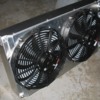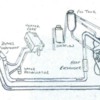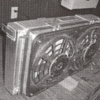Hey guys. I'm having a new custom radiator built by the guys at "Be Cool" custom radiators. www.becool.com
I'm having them reverse the the top attaching ears so I can lean the radiator forward and put sucker fans on the rear. I am also having them use appropriate tubing for the hose attachment so I don't have problems attaching the 1 3/8 hose to the radiator. They have discussed having the tubing come out of the radiator at an angle similar to stock only extended to clear the rear mounted fans. This way I should be able to use strait pieces of 1 3/8 hose to connect to stock pipes. I am also considering using 3/8 NPT bungs for the temp sensors so I can use common of the shelf sensor's. While I'm at it I am using Pantera-Electronics fan system that uses a 3/8 NPT sensor.
I am still debating how the sucker fans will be mounted either with or without an shroud. I have seen aftermarket fans done both ways. It appears at low speeds an enclosure would help the fans pull air through the entire radiator; however, at speed the rear enclosure would restrict air flow to only the air that could flow through the fan openings. Any thoughts?
They also offer a black finish that apparently does not affect performance and keeps a more original look, at least from the outside of the car.
My car has a rebuilt Cleveland engine that we assume will be in the upper 500hp range so I want to make sure I get all the cooling I need.
Does anybody have any other thoughts of what they might want in a radiator if the sky is the limit, like relocating the drain or vent etc?
Original Post





